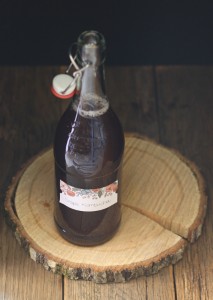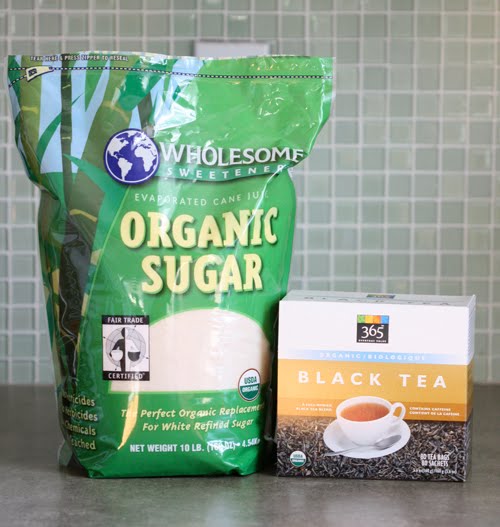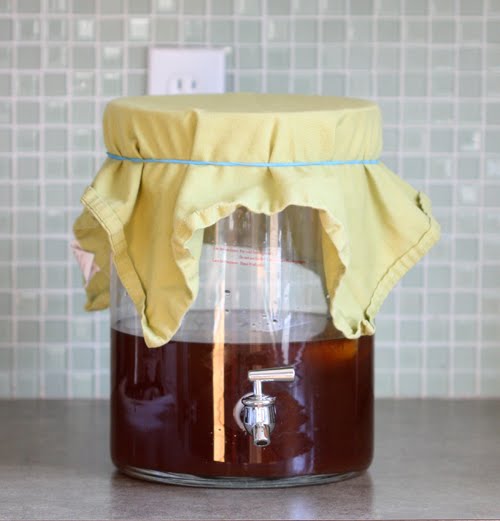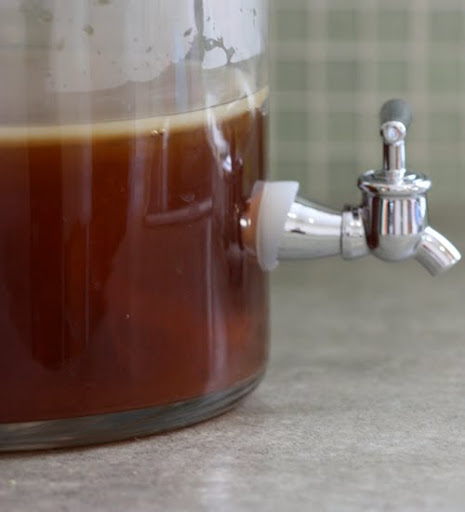 A couple years ago my friend and I were at the local Natural Grocers, and she bought a Kombucha. “What is that?” I asked. She explained that Kombucha is a probiotic drink, made from something like a mushroom. I’m a huge believer in probiotics, homemade yogurt, and cultured veggies, so I bought one too, and I liked it.
A couple years ago my friend and I were at the local Natural Grocers, and she bought a Kombucha. “What is that?” I asked. She explained that Kombucha is a probiotic drink, made from something like a mushroom. I’m a huge believer in probiotics, homemade yogurt, and cultured veggies, so I bought one too, and I liked it.
(Read about the health benefits of Kombucha and why Ronald Reagan drank it.)
Then a week later I bought another one. Then another one. And so on. I was hooked. Like I crave my homemade yogurt and cultured veggies, I now also crave Kombucha. But this stuff really adds up. They cost about three dollars per drink in the store. Yikes.
I heard about making Kombucha at home, but I thought it would gross me out too much. With time I came around to the idea. So when another friend told me that she made her own Kombucha, I was so excited. She told me to start collecting my equipment, and offered to give me a SCOBY. That’s how it happened.
First I got organic sugar at Costco. That was weird for me. I wondered if anyone would see me buying the sugar. So if you did, then now you know why 🙂 My husband had organic black tea already, so that was done.

Next I bought a huge pitcher with a spout, which can hold two gallons at a time. I’m not using the base so I can keep my Kombucha on the counter, under the cabinets, where it’s warm (the pantry or the basement would be too cold). I’m not using the lid, because you have to let the Kombucha breathe by covering it with a cloth and rubber band.

Making Kombucha, Day 1
If you don’t have a friend who can give you a SCOBY you can make one yourself. Learn how by clicking HERE.
Here is what you need to make your own Kombucha
- a SCOBY (Symbiotic Colony of Bacteria and Yeast)
- reverse osmosis water (I’m told RO water is best, because there is chlorine, fluoride, etc in tap water)
- organic black or green tea, without added oils (Earl Grey, for example, contains bergamot oil), because the oils can cause mold
- organic evaporated cane juice, not bleached (This is what it eats.)
- a glass container (they’re really common now, I see them at Target all the time)
How to make your Kombucha:
Using a medium sized pot, bring a gallon of water to a boil. Turn off the heat. Add a cup of organic sugar and 8 bags of organic black or green tea the water. Steep the tea for about 15 minutes, then remove the bags with clean tongs. Put the lid on the pot of sweetened tea and let it cool overnight. (It must be room temperature to continue.)
Make sure your glass container is nice and clean. Carefully pour the room temperature sweet tea into the container. Add one cup of Kombucha either from the previous batch or plain store-bought Kombucha (not flavored).
Add your SCOBY. (make sure your hands are clean if you use them). Cover the container with a cloth and rubber band. Keep your brew somewhere warm (around 70 degrees F), out of direct sunlight, and at least several feet from anything else you’re culturing, like yogurt of sauerkraut. Brew for 7 to 30 days. A new culture will form on top. The longer it sits the thicker it will become.


After the culture has formed on top.
Brown wispy yeast tails are normal. They are a byproduct of the fermentation. If you ever see green mold you must throw everything out. The longer you brew your Kombucha the less sugar it has, so go ahead and keep brewing until you get the flavor you like.
When your Kombucha tastes to your liking you can put it in canning jars or a glass pitcher. Remove the culture and strain those yeast tails out if you want. Always use clean hands and clean equipment. Remember to save some Kombucha for your next batch before adding fruit juice or ginger.
At this point you can put it in your refrigerator and begin drinking it, OR do a second fermentation to make it bubbly. Even though the culture is removed, the natural bacteria and yeast will continue to eat the sugar and create gas in an airtight container. This gives Kombucha a soda-like fizz.
If you choose to do the second fermentation, keep your Kombucha in a glass airtight container at room temperature for another 2 to 5 days. Open the lid once a day during this time so that the pressure doesn’t build up too much. When you open a Kombucha that has done a second fermentation you can cover the lid with a towel and release it very slowly just in case.
There will be very little sugar left in your Kombucha after this process is complete. Refrigerate your Kombucha after the second fermentation (which lasts 2 to 5 days). Every few batches the SCOBY will “have a baby,” that can be used as compost or given to a friend.
UPDATE: Some great questions in the comments now. Make sure to check them out! 🙂
♥, Kelly


GF Gidget says
I made my own batch of Kombucha once, but it made my house smell like vinegar. My husband was none too thrilled about the smell. hahaha
InnaC says
Love, love, love Kombucha! My husband is not too thrilled with the smell ether, so I make new batches when he’s at work and air the house well. It doesn’t smell when it’s brewing in the cupboard.
SunnyB @ andloveittoo says
I wonder if this would work with herbal tea? Any suggestions?
JaimeG says
Can you use caffeine free tea?
susiet says
Wow, great and clear instructions. Just love your blog. 🙂
Can you describe the flavor of Kombucha?
Kelly says
Thank you!
I’ve heard that black or green tea (Caffeine-free works too) and evaporated cane juice are the best for tea and sugar because they keep the pH at the right level to prevent mold.
I don’t know how to describe the taste. Some people say it’s similar to hard cider or beer. To me it tastes like a carbonated probiotic drink 🙂
Kathy Fannon, CHHC says
I think it tastes a bit like apple cider vinegar, which I love, so I was immediately a fan of kombucha!
I have a friend who bought the large jars of pickles for about $3.50 each at Costco to make her kombucha in. Even without eating the pickles, the jars were cheaper than the special ones.
Anonymous says
Great idea on the pickle jars at Costco, Kathy.
Kelly I totally know what you’re saying about that same big bag of sugar from Costco, it feels like you’re buying contraban…ha! I had mine when I was on a Kefir water kick but ended up throwing half the bag away when we moved to FL. Thanks for posting the recipe and I may have to get to Costco here in Jacksonville to buy another bag, luckily, nobody knows me here in FL. :o) Hope
Meghan @ Whole Natural Life says
I buy that same bag of sugar for my water kefir and kombucha. 🙂 Maybe even at the same Costco as you, since I live in Boulder. It’s always funny putting it in the cart, since it’s surrounded by super healthy stuff like wild salmon, grass-fed butter and organic veggies. I think it makes it look like I have a major sugar addiction – but in truth I only use it for my ferments!
Tasty Eats At Home says
Just listening and catching up to your podcasts, so I find it’s funny that you finally took the plunge and made this! Glad you did. I personally love kombucha.
girlingreen says
Hi, has anyone tried this with agave nectar? and I’m a little confused about the SCOBY -do I just buy the raw Kombucha and add it to my tea and I’m ready to go or do I need to grow the film thing on top for a few weeks before transferring that and making my actual Kombucha? I love this blog. I stood in the isle of Martin’s in front of the Kombucha and told three different women about the “Spunky Coconut” (no, no “c” in the spunky…”
Laura says
Thanks so much for posting this- it’s like you read my mind. I am making my first batch of cultured veggies right now and wanted to make my own kombucha since I buy it all the time. I can’t wait to try this!!!
Dave says
great post. to GF Gidget.. ha ha yes when I first got started it was hard to have people come over to my house because they didn’t like the smell.. BUT when they drank my kombucha tea, I couldnt get them to stop coming over 🙂
Great job Spunky Coconut, the sugar you use is the exact brand we partnered with for our
kombucha starter kits.
Let me know if you ever want to write a guest post on our blog as we allways love great quality content by real people!
Happy Brewin’
Dave
Kelly says
Girl in Green,
Yes, you have to grow a SCOBY first. Follow the instructions in the link above the ingredients 🙂
Thanks everyone!
Amanda says
I have read multiple sources that say using organic ingredients in kombucha making increases chances for mold and bacteria growth. i sometimes make mine with organic sugar because that what i usually have, but wondering your opinion/experience with this?
Also, I love to use Jasmine Green tea…I think it creates a wonderful end product!
jmh256 says
Great article. I make mine in a large glass jar and have been looking for a container with a spout for awhile — do you have any concerns with the metal spout?
Anonymous says
Is it ok to double the recipe?
Anyone ever have any fermenting problems by doing so?
Mac says
Is it important to have a metal spout on the glass jar, as opposed to a plastic, or “chrome” coated plastic one? Thanks!
Jessica Klieman says
The link to your jar get you to a $100 crystal pedestal jar with a fancy lid not like your picture. Any updates on the jar you bought. Thank you
Kelly says
That is the one I use. I took off the base so it would fit on my counter under the cabinets. It works great if you want to make two gallons at a time. Haven’t had any trouble with the spout clogging either : )
Jessie says
Can you use spring water instead of reverse osmosis water?
Curtis Gantt says
Reverse osmosis in Perth is nice and I prefer getting my supply there. I am afraid to create my own probiotic drink but I will give this a try. I have a stock of RO at the moment so I think I can try this on weekend.
Saucy Spatula says
Great post! Thank you so much for sharing!
Anonymous says
Can containers with spigots be used for continuous brew? What is the difference in the continuous brew vessels sold by Kombucha Mamma?
Anonymous says
Can containers with spigots be used for continuous brew? What is the difference in the continuous brew vessels sold by Kombucha Mamma?
Anonymous says
Can containers with spigots be used for continuous brew? What is the difference in the continuous brew vessels sold by Kombucha Mamma?